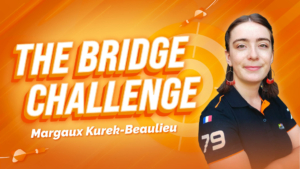
The Invincible Zia tournament analysis – August
Named ACBL player of the year many times,world champion and member of the Hall of Fame, Zia Mahmood gives you a hard time every month during Funbridge Points Tournament!
Discover 3 deals analysed by Zia Mahmood from his August tournament.

Deal 12
 |
| West | North | East | South Zia |
| PASS | PASS | ||
| PASS | PASS | ||
| PASS | PASS | PASS | |
| PASS |
Have you ever thought “I hope suits break really badly and all my finesses lose?” No, not because you hate your partner, or yourself, or the game of bridge in general – but because you hate your contract, and the only way to avoid a terrible score is for things to go terribly in the play.
That was my reaction on this deal from the August tournament. I might have chosen to open 2 NT with the South hand – it’s only 19 points, yes, but you have a couple of four-card suits with intermediate cards and you have a lot of controls (aces and kings). Instead I settled for the less aggressive 1 ♣ opening, rebidding 2 NT over my robot partner’s 1 ♥ response.
North’s 3 ♥ was forcing – it’s not really practical to play that you can sign off over a 2 NT rebid unless you have some gadget for the purpose. My heart support was as bad as it could be, so 3 NT was my natural call, and partner bid 4 ♥. This was a slam try – if all it had wanted to do was play in 4 ♥ it would have bid it immediately over 2 NT. But it could have made a control-showing bid in a minor suit – maybe 4 ♦ with the King – and its failure to do that convinced me that my long suits might not be much use.
So I completed a craven performance by passing 4 ♥ and a few moments later, as I was moved to the North seat to play the hand, I found myself in the position I mentioned earlier – hoping that hearts would be 4-1 and ♦ K would be with West, so that slam would go down. Of course, bad breaks only happen when you don’t want them, so I recorded an ignominious +510 for three overtricks. That was a 17% score and a lesson learned – 2 NT next time, partner, I promise.
Deal 5
 |
| West | North | East | South Zia |
| PASS | PASS | ||
| PASS | PASS | PASS |
At IMPs or money bridge, missing a slam is a blow from which it can take a while to recover. At matchpoints, an overtrick or two can immediately cancel out the disaster and put you back on an even keel. The South hand is an awkward one after partner opens 1 ♠ – a 2♦ response is forcing to game and is a bit much with only 10 points and no guarantee of a fit, but a 1 NT response will often be passed by partner when it is pretty seriously the wrong contract.
As you’ll have seen from the first hand I was in a cautious mood when it came to the bidding, so I made the weaker response and hoped it did not lead us too far astray. No one had anything further to contribute, and West led ♣J (with spades bid on its left, the robot was not going to lead its strongest suit).
East ducked the club lead to my King, and I advanced a low diamond. West had to play low to give me any real chance to go wrong, but this would be hard for any defender – man or machine. When it went up with ♦ Q and pursued the attack on clubs I was able to take two spade tricks, two hearts, five diamonds and two clubs for 11 tricks in all and an 82% board.
Deal 4
 |
| West | North | East | South Zia |
| PASS | PASS | ||
| Double | |||
| PASS | PASS | ||
| PASS | PASS | PASS |
A really great bridge book is To Bid or Not to Bid, by the top American player Larry Cohen. Its premise is the Law of Total Tricks, which says that the total number of tricks on a deal is the total number of trumps each side has in its best fit. Sometimes, though, that’s not quite the case.
West opened 1 ♥ in third seat, and after my robot doubled East produced 1 ♠ – clearly it was a member of the “ignore the double” school. To have a takeout double of my own available would be nice, but a double of 1 ♠ is usually played as penalty, so I bid my higher-ranking four-card suit. West supported his partner’s spades, and when that came back to me I was delighted to be able to compete in my second suit, and 3 ♣ became the final contract.
The machines were ruthless in defence. ♥ A, ♥ K, ♥ 9 over-ruffing dummy’s ♣ 7 with the Jack, and a diamond shift, I won in dummy and played a club. Ace from East, diamond ruffed by West, down one before I had a chance to draw breath.
Still, that was all right. They had eight spades and we had eight clubs, for a total of 16 trumps, so there should be 16 tricks according to the Law. That meant they would score 110 in 2 ♠, so minus 100 should be a good score four our side, no?
No. In fact, it was worth a paltry 18%. You see, there were indeed eight tricks available in spades – but not to East-West. If we start by playing four rounds of trumps, the best declarer can do is make one spade trick, three hearts and one club. “Curious hand”, said Oscar the Owl. “North-South can take eight tricks not only in their best fit, but also in their worst one.”



